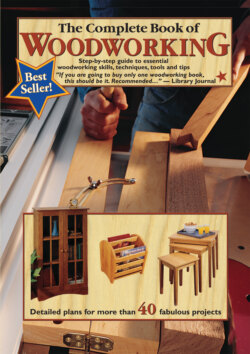Читать книгу Draw Manga - Tom Carpenter - Страница 11
На сайте Литреса книга снята с продажи.
Workpiece Support
ОглавлениеFurnish your shop with a number of convenient (and preferably portable) work supports. Adequate workpiece support is critical to making accurate, safe cuts. Most woodworkers have several different types of work supports in their shop, from manufactured, adjustable outfeed supports to saw table extensions. A few sturdy pairs of sawhorses will also come in handy. And you can use rolling caster bases for your benches or other stationary tools to set the top surfaces at a uniform height.
A power miter saw workstation with auxiliary tables and fences lets you support and cut longer stock without having to set up additional supporting devices first. Keeping your portable tools in one spot as much as possible also prevents them from falling out of square as readily.
Make room for sawing. Allow 4 ft. of clear space on each side of a table saw and 8 to 10 ft. in front and in back so you’ll have plenty of room to work. Be sure to have adequate outfeed support in place when cutting larger stock.
“Sturdy” and “movable” are the two most important characteristics of good work support. Casters can make just about any shop furnishing into a useful work support (photo above). And you can never have too many sawhorses or portable workstations (above photo).
Tips for setting up & equipping a safe workshop
Protect hearing with ear muffs (A) expandable foam earplugs (B) or corded ear inserts (C).
Protect against dust & fumes. A particle mask (A) is for general work. A dust mask (B) has replaceable filters. A respirator (C) can be fitted with filters and cartridges.
Protect eyes. A face shield (A) is for very hazardous work. Safety goggles (B) and glasses (C) with shatterproof lenses are for general cutting and shop work.
Create an emergency area The workshop is perhaps the most accident-prone area of your home. Sharp blades, heavy objects, dangerous chemicals and flammable materials are just a few of the factors that increase the risk of accidents in the shop. While good housekeeping, respect for your tools and common sense will go a long way toward reducing the risk of accidents, you should still be prepared in the event an accident occurs. Designate part of your shop as an emergency center. Equip it with a fully stocked first aid kit, fire extinguisher and telephone with emergency numbers clearly posted.
A first aid kit should contain (as a minimum) plenty of gauze and bandages, antiseptic first aid ointment, latex gloves, a cold compress, rubbing alcohol swabs, a general disinfectant such as iodine and a first aid guidebook.
Stay alert A lapse in concentration brought on by physical or mental fatigue is responsible for most shop accidents. A few simple precautions, like setting a cushioned floor mat at your workstations, can help reduce physical fatigue. Take plenty of breaks to stay mentally alert and never work with tools if you’ve consumed drugs or alcohol.
